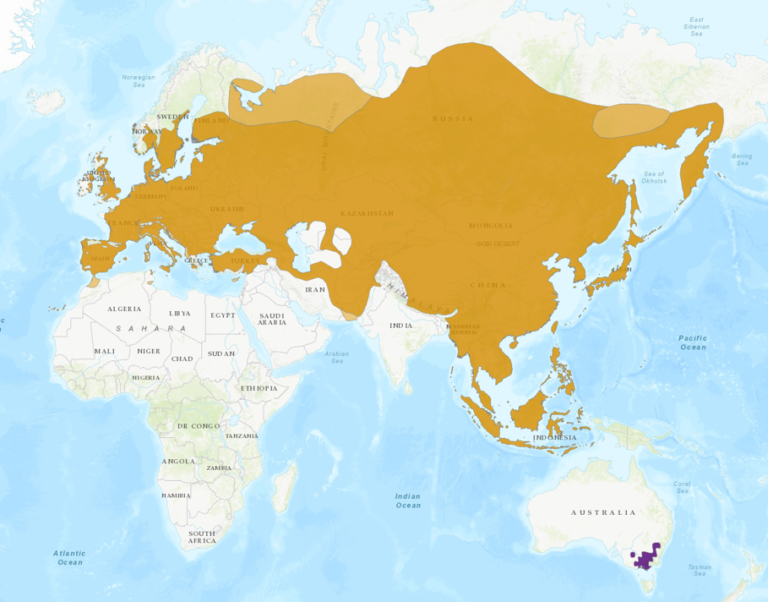Birdfinding.info ⇒ Abundant and familiar throughout most of its range—especially in East Asia, where it seems to occupy the niche that the House Sparrow dominates elsewhere. The introduced U.S. population is most abundant in bottomlands of the Mississippi River and some tributaries. It can be found reliably near St. Louis, Missouri, at Cora Island and Columbia Bottom, and parks on the south side such as Carondelet, Jefferson Barracks, and Officer Blake C. Snyder. Other consistent sites include Clarence Cannon and Chautauqua National Wildlife Refuges and the riverfronts of Davenport, Iowa, and Moline, Illinois. (See Breeding Bird Survey Abundance Map in Notes, below.)
Eurasian Tree Sparrow
Passer montanus
Family: Passeridae
Widespread throughout most of Eurasia. Lives in close association with humanity in cities, towns, and farmland, and generally in mixed and semiopen habitats.
Occurs across almost all of Europe from the British Isles, the Faroes, and northern Scandinavia to the Mediterranean, then continuously eastward across most of temperate Asia south into the mountains of northern Iran, Afghanistan, and Pakistan, and sparsely farther south but generally not south into the arid Middle East, and generally absent from the Indian subcontinent.
Most widespread in eastern Asia, where its distribution spans from Lake Baikal, the northern Okhotsk coast, and the Kamchatka Peninsula to the tropics from Bangladesh eastward and south through the Malay Peninsula, the Philippines, Indonesia, and New Guinea to the Bismarck Archipelago. Also on the Commander and Kurile Islands, Japan, the Ryukyus, Taiwan, and parts of Micronesia: Palau, the Marianas, and the Caroline Islands east to Pohnpei.
Introduced populations are well-established in the North American Midwest and southeastern Australia.
In North America, it is well-established around St. Louis, Missouri, and locally northwest to central Iowa and northeast to north-central Illinois. Regularly wanders in small numbers much farther northwest, to southern Saskatchewan and Manitoba, and east across the Great Lakes area, exceptionally as far as Toronto, Ontario.
In Australia, it is established around Melbourne, Victoria. Occasionally wanders in small numbers north to the interior of New South Wales. Also recorded from the vicinity of Darwin, Northern Territory and islands of the Torres Strait in Queensland—but these may be natural colonists from Indonesia, perhaps aided by vessel traffic.
Identification
One of the world’s most familiar birds, but less so than the similar and closely related House Sparrow. Readily recognized by the distinctive black spot on its whitish cheek, as well as the combination of a solid-chestnut crown and black mask and beard.
The upperparts are streaked brown, black, and tan, with an unstreaked, grayish-tan rump.
The underparts are unmarked, mostly pale-gray, sometimes partly tan, especially on the flanks.
The sexes are similar. Immatures resemble adults but lack the crisp facial pattern.

Eurasian Tree Sparrow. (Pervomayskiy, Altay, Russia; April 29, 2020.) © svetlanaagafonova

Eurasian Tree Sparrow. (Torino, Italy; June 12, 2016.) © sandro251

Eurasian Tree Sparrow. (Mill Park Lakes, Whittlesea, Victoria, Australia; April 4, 2017.) © David Adam

Eurasian Tree Sparrow. (Moscow, Russia; February 23, 2019.) © Marina Nikonorova

Eurasian Tree Sparrow. (St. Louis, Missouri; January 10, 2010.) © Steve Collins

Eurasian Tree Sparrow. (Jihomoravský Kraj, Czech Republic; May 9, 2015.) © Pavel Štěpánek
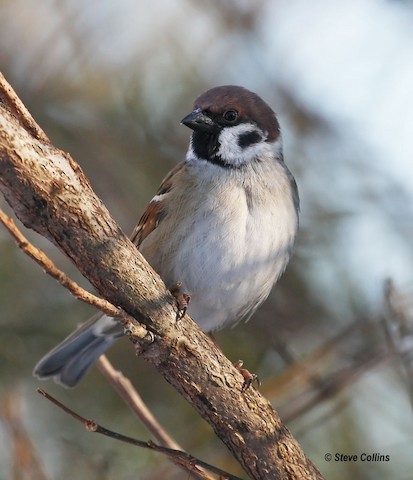
Eurasian Tree Sparrow. (St. Louis, Missouri; January 10, 2010.) © Steve Collins
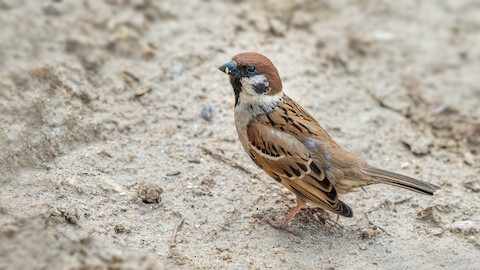
Eurasian Tree Sparrow. (Punakha, Bhutan; April 20, 2016.) © Abhishek Das

Eurasian Tree Sparrow. (Göttingen, Niedersachsen, Germany; November 24, 2019.) © Volker Hesse
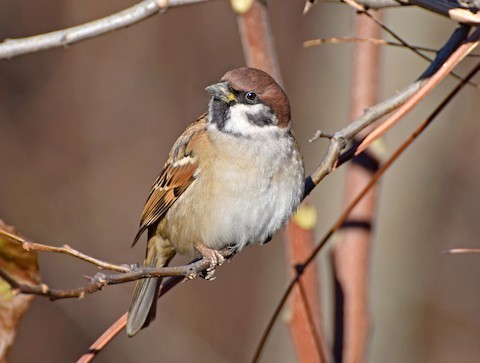
Eurasian Tree Sparrow. (Košutnjak, Beograd, Serbia; December 8, 2017.) © Aleksandar Urošević
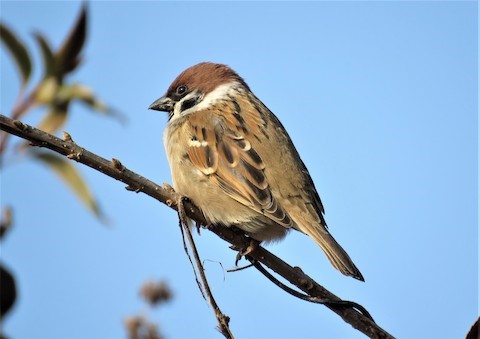
Eurasian Tree Sparrow, showing unmarked rump. (Jochiwon-eup, Yeongi-gun, Chungcheongnam-do, South Korea; December 9, 2019.) © Elizabeth Skakoon
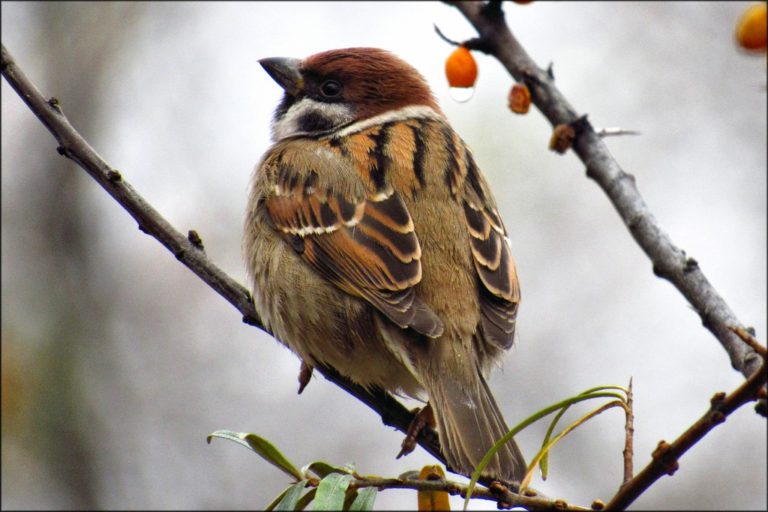
Eurasian Tree Sparrow. (Kursk, Russia; October 26, 2019.) © shure-61
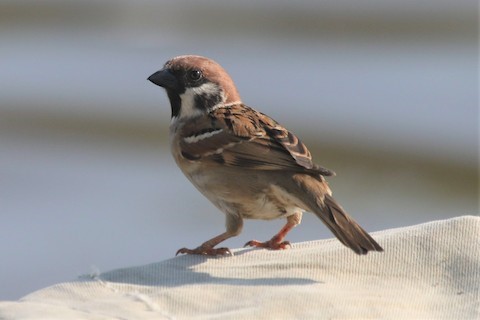
Eurasian Tree Sparrow. (Phnom Krom, Cambodia; December 24, 2019.) © Fabio Olmos
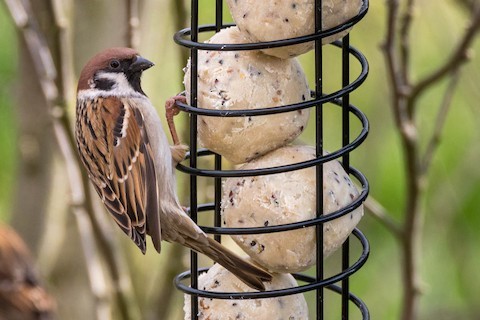
Eurasian Tree Sparrow. (Úvaly, Středočeský, Czech Republic; March 17, 2020.) © Honza Grünwald
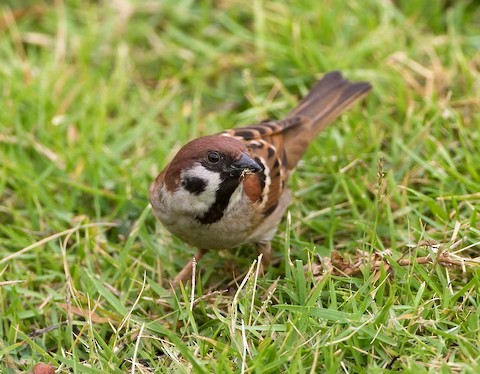
Eurasian Tree Sparrow. (Bangkok, Thailand; March 13, 2013.) © Marco Valentini

Eurasian Tree Sparrow in flight. (Taipei Botanical Garden, Taipei, Taiwan; May 11, 2018.) © Cheng Ching Lu

Eurasian Tree Sparrow. (St. Petersburg, Russia; January 5, 2020.) © Igor Dvurekov
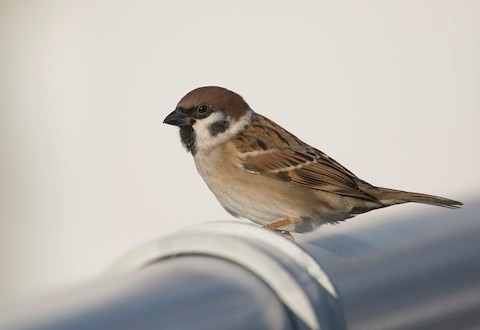
Eurasian Tree Sparrow. (Yangguang Sports Park, Taipei, Taiwan; February 14, 2018.) © Jerry Ting

Eurasian Tree Sparrow. (St. Louis, Missouri; April 11, 2019.) © Colleen Burgess Crank
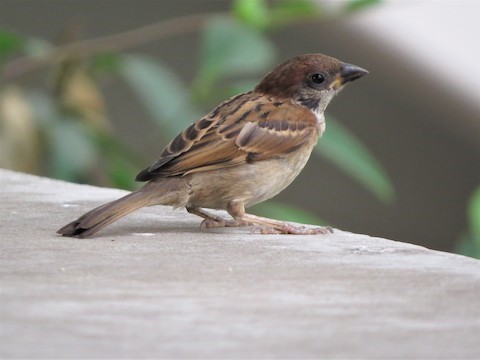
Eurasian Tree Sparrow, immature. (Chinatown, Singapore; March 9, 2020.) © Glenda Fitzpatrick

Eurasian Tree Sparrow, immature. (Chiyoda City, Tokyo, Japan; September 6, 2018.) Anonymous eBirder

Eurasian Tree Sparrow, immature. (Taito, Tokyo, Japan; October 10, 2018.) © Tony Iwane

Eurasian Tree Sparrow, immature. (Salamanca, Castilla y León, Spain; June 30, 2020.) © Carlos Alberto Ramírez
Voice. Typical call is a full-bodied but generic chirp, often repeated: In flight, often gives quick rattles, tik-tik or tik-tik-tik:Also a metallic, bisyllabic whistled tsoo-it:Song consists of series its typical call notes, sometimes with occasional whistles or rattles interspersed:
Notes
Polytypic species consisting of nine recognized subspecies.
References
Alderfer, J., and J.L. Dunn. 2014. National Geographic Complete Birds of North America (Second Edition). National Geographic Society, Washington, D.C.
BirdLife International. 2017. Passer montanus (amended version of 2017 assessment). The IUCN Red List of Threatened Species 2017: e.T22718270A119216586. https://dx.doi.org/10.2305/IUCN.UK.2017-3.RLTS.T22718270A119216586.en. (Accessed October 3, 2020.)
Brazil, M. 2009. Birds of East Asia. Princeton University Press, Princeton, N.J.
Clement, P., A. Harris, and J. Davis. 1993. Finches and Sparrows: An Identification Guide. Princeton University Press.
eBird. 2020. eBird: An online database of bird distribution and abundance. Cornell Lab of Ornithology, Ithaca, N.Y. http://www.ebird.org. (Accessed October 3, 2020.)
Hollom, P.A.D., R.F. Porter, S. Christensen, and I. Willis. 1988. Birds of the Middle East and North Africa. T & AD Poyser, Calton, England.
Mullarney, K., L. Svensson, D. Zetterström, and P.J. Grant. 1999. Birds of Europe. Princeton University Press.
Robson, C. 2002. Birds of Thailand. Princeton University Press.
Sibley, D.A. 2000. The Sibley Guide to Birds. Alfred A. Knopf. New York.
Xeno-Canto. 2020. Eurasian Tree Sparrow – Passer montanus. https://www.xeno-canto.org/species/Passer-montanus. (Accessed October 3, 2020.)

